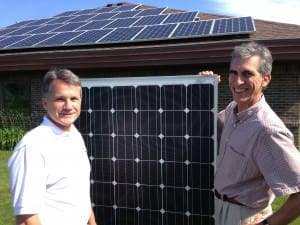IndianaDG wants to know if the cost of Duke Energy's Edwardsport IGCC plant should be used in determining Duke's "avoided cost" for cogeneration and alternative energy production. Each year Indiana's electric investor owned utilities file these rates with the Indiana Utility Regulatory Commission (IURC).
In a recent White Paper by Washington, D.C. attorney Carolyn Elefant entitled, REVIVING PURPA"S PURPOSE: The Limits of Existing State Avoided Cost Ratemaking Methodologies In Supporting Alternative Energy Development and a Proposed Path for Reform, she explains the history of "avoided cost" under PURPA:
"Because of the inability of independent power producers to sell their efficient and clean electricity into monopoly-controlled markets, Congress in 1978 enacted the Public Utilities Regulatory Policies Act (PURPA). PURPA encouraged the development of alternative power, including renewable energy and cogeneration by requiring utilities to purchase energy and capacity from qualifying facilities (QFs) at their incremental, or avoided costs."
"...this report undertook a comprehensive review...of the different ways by which state utility commissions calculate avoided cost rates for QF's under PURPA to identify the factors and underlying state policies that account for the board range of approaches."
"...the report found that many developers are unable to fully capitalize on PURPA's benefits in light of factors such as the complex, Byzantine nature of avoided cost ratemaing at the state level which makes avoided cost ratemaking difficult for developers and regulators to fully understand."
"This report concludes that PURPA can still serve as an important policy tool for development of small power producers, including renewables and CHP. However, states need additional guidance on which avoided cost methodologies are most favorable to small power producers as well as an understanding of the range of options--such as resource specific avoided cost rates and ability to account for avoided environmental costs--available to them in setting avoided cost rates."
Can you believe that Duke Energy Indiana claims their "avoided cost" is only $0.028541/kWh with a capacity payment of merely $7.05/kW/mo?
Do you agree with IndianaDG that we need to shed some light on both the formula contained in the Indiana Administration Code (170 IAC 4-4.1) as well as the specific inputs utilities are permitted to plug into this formula?
Step one is to determine the true cost of Duke Energy's Edwardsport plant and then step two is to use that cost information to recalculate Duke Energy's avoided costs.
Please join us in calling for a review of the IURC's avoided cost procedures. Contact me at Laura.Arnold@IndianaDG.net.
Laura Ann Arnold.
http://kokomotribune.com/opinion/x1912990109/KERWIN-OLSON-Whats-the-true-cost
June 21, 2013
KERWIN OLSON: What's the true cost?
Nearly $3B yet to be accounted for on Edwardsport plant.
Kokomo Tribune
---- — Now that Duke Energy’s Edwards-port coal gasification plant is allegedly “commercial” as of June 7, it’s once again time to set the record straight and fill in the blanks. For more than seven years now, Duke and the Indiana Utility Regulatory Commission have conveniently left out information they prefer the public not be told, as perhaps the truth is too inconvenient.
Duke, along with the IURC, continues to perpetuate the myth that the plant will result in just a 14.5 percent rate increase. The reality is this 14.5 percent represents only a portion of the financing costs for the project. Additional financing costs of at least $320 million, as well as the actual construction costs currently capped at $2.595 billion, are not included.
That 14.5 percent only represents the approximately $665 million in construction-work-in-progress charges, or CWIP, a tracker or extra fee tacked onto the bill of captive Duke ratepayers. How much more will monthly bills increase after the other $3 billion is factored into rates? Ask Duke or the IURC … see if you can get a straight answer.
Duke is already collecting approximately $30 million per month from ratepayers just for financing costs. In fact, Duke ratepayers will pay more just for the financing charges for the Edwardsport fiasco than Indianapolis Power & Light is seeking in total for its proposed natural gas plant in Morgan County, a plant that will produce approximately the same amount of power.
Duke claims its construction costs are capped at $2.595 billion, but that isn’t accurate. Duke declared the plant “in-service” on June 7, which effectively marks the end of this so-called “cost cap” from the settlement. From this date forward, ratepayers can potentially be stuck with every dollar Duke spends on the plant, and there remains a lengthy “punch-list” of items that are yet to be completed. So, the settlement effectively exposes consumers to the potential of significant costs outside of the cap, which was intended to protect them.
Lastly, it needs to be understood that the IURC has declined to protect consumers from a white elephant by refusing to place any operational or performance requirements on the Edwardsport plant. Despite this plant being a first-of-its-kind technology, never built or operated at this scale anywhere in the world, if it doesn’t work or operates at less than the 85 percent capacity factor that Duke opined the plant will achieve, Duke ratepayers are stuck with the bill, no questions asked. As long as the plant runs for even a minute, Duke gets the full amount.
With Duke already collecting more than $30 million per month from customers for this plant, which is already two years behind schedule, Duke indicates it will be another 15 months before the plant is expected to have its “long-term level of availability” — whatever that means. Duke has been less than forthcoming every step of the way with this boondoggle … why should anyone believe them now?
Kerwin Olson is executive director of the Citizens Action Coalition. Contact him at kolson@citact.org.





